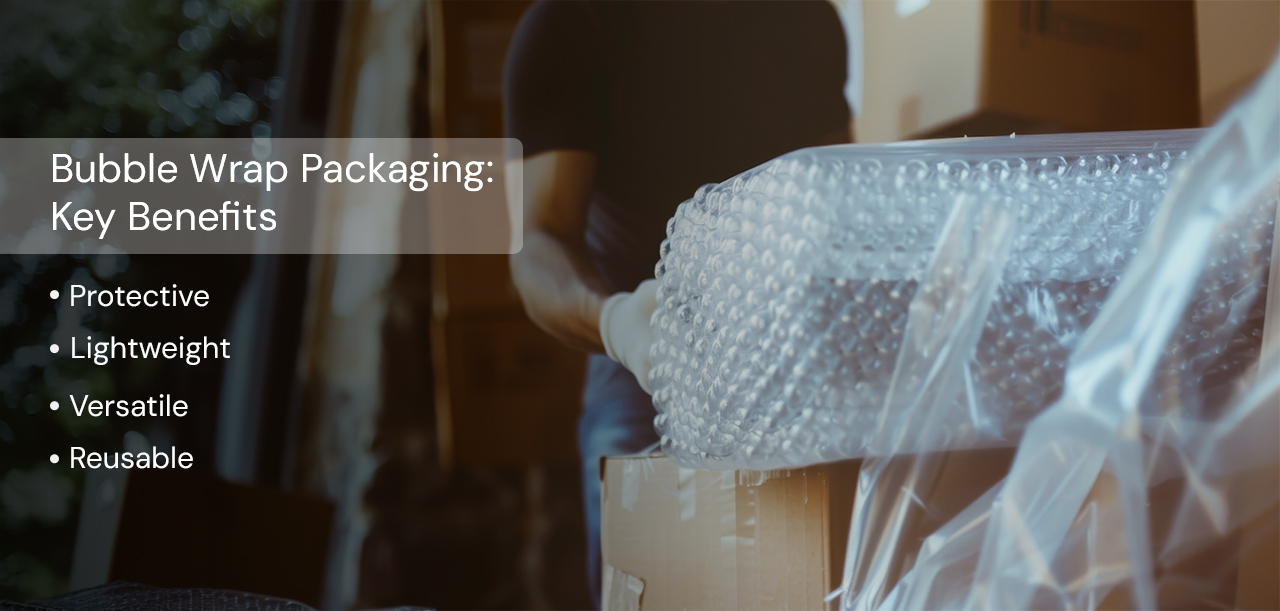Millions of packages crisscross the globe daily, carrying everything from delicate glassware to high-tech electronics. Yet, Packaging Digest reports that up to 11% of goods shipped globally suffer damage during transit, leading to billions in losses annually.
For businesses, ensuring products arrive in perfect condition isn’t just about avoiding returns—it’s about protecting customer trust and brand reputation. Enter bubble wrap: a packaging champion that has reduced shipping damages by 85%, according to AMERIPEN.
From fragile wine bottles to cutting-edge smartphones, bubble wrap has proven its worth in countless industries.
In this article, SCI explores why bubble wrap remains indispensable for protective packaging, its unmatched benefits, and how businesses can maximize this tried-and-true material.
The Science Behind Bubble Wrap’s Effectiveness
Bubble wrap was first used in packaging logistics in 1961 when IBM adopted it to protect its 1401 computer during shipping. Alfred Fielding and Marc Chavannes invented it in 1957 as textured wallpaper, but its potential as a packaging material became evident after the wallpaper idea failed. This marked the beginning of bubble wrap’s critical role in logistics and eCommerce.
The bubble wrap’s design—air-filled bubbles encased in a plastic film—offers exceptional cushioning by absorbing shocks and vibrations during transit. Each bubble acts as a miniature air cushion, distributing force evenly across the surface and preventing localized impact damage. This makes it ideal for packing bubble wrap around fragile items like glass bottles or sensitive electronics.
4 Key Benefits of Bubble Wrap for Packaging

01 | Superior Protection
Bubble wrap provides unmatched protection against drops, bumps, and vibrations. It is especially effective for oddly shaped or delicate items. Shipping companies often rely on bubble packing wrap to transport everything from antiques to laboratory equipment safely.
02 | Lightweight Material
Shipping costs often depend on the package’s weight, and bubble wrap adds minimal bulk. This makes it an economical choice for businesses managing large-scale operations, such as e-commerce platforms like Amazon or Etsy sellers.
03 | Versatility
Available in various sizes and grades, bubble wrap can be tailored to fit any packaging need. From small bubble sizes for lightweight items to large bubbles for heavy-duty protection, businesses can choose the appropriate type of packaging bubble wrap to match their requirements.
04 | Reusable and Sustainable
While bubble wrap is primarily made of plastic, many companies are now producing recyclable or biodegradable versions. Businesses focused on sustainability can reduce waste by reusing bubble wrap or sourcing eco-friendly variants.
Applications Across Industries
eCommerce and Retail
In the era of online shopping, packaging plays a critical role in customer satisfaction. A torn or damaged item can lead to negative reviews and returns. eCommerce giants use bubble wrap in bulk to secure items ranging from clothing to electronics.
For instance, smartphone manufacturers like Apple use custom bubble wraps to ensure devices are scratch-free upon arrival.
Food and Beverage
Transporting wine bottles or gourmet products? Bubble wrap ensures these fragile items survive long-distance shipping without breaking.
According to Wine America’s report, the wine industry contributed $276 billion to the U.S. economy in 2022. The industry heavily relies on bubble wrap wholesale suppliers for secure shipping.
Healthcare and Pharmaceuticals
Medical supplies and sensitive laboratory equipment require impeccable protection during transit. Bubble wrap’s shock-absorbing properties make it indispensable for this sector.
Statistics That Highlight Bubble Wrap’s Impact
- Damage Reduction: According to a 2023 report by Statista, products packaged in bubble wrap have a 78% lower return rate due to shipping damage compared to products packed in other materials.
- Cost-Effectiveness: Global Market Insights Inc. reports that the bubble wrap market is projected to grow at a CAGR of 3.8% from 2024 to 2032, emphasizing its continued demand and utility.
- Environmental Progress: Numerous packaging companies now offer recyclable bubble wrap options, addressing concerns about sustainability.
4 SCI Tips for Buying Bubble Wrap
01 | Determine Your Needs
Consider the size, weight, and fragility of your items. To save costs on bulk shipping, opt for bubble wrap wholesale.
02 | Choose the Right Bubble Size

- Small bubbles (3/16” ): Best for lightweight or surface protection.
- Large bubbles (1/2” ): Ideal for heavy or large items requiring extra cushioning.
03 | Look for Eco-Friendly Options
Many suppliers now offer biodegradable or recyclable bubble wrap for packing. This is an excellent option for businesses prioritizing sustainability.
04 | Buy in Bulk
Purchasing bubble wrap in bulk from the best place to buy bubble wrap, such as SCI, can significantly reduce costs.
The Future of Bubble Wrap in Logistics
As logistics evolves, so does the demand for better protective packaging. While alternatives like foam or paper exist, bubble wrap remains a favorite due to its superior protection and versatility. With advancements in eco-friendly materials, the future of packaging bubble wrap looks brighter than ever.
Concluding Thoughts
Bubble wrap is more than just a packaging material; it’s a logistical necessity that ensures products reach their destination intact. Investing in high-quality bubble wrap is a no-brainer whether you’re shipping delicate artifacts occasionally or transporting hundreds of items daily.
For businesses, sourcing bubble wrap wholesale from the best place to buy bubble wrap can enhance operational efficiency while minimizing costs. And with the growing availability of eco-friendly options, businesses can simultaneously protect their goods and the planet.
Bubble wrap has lasted for over six decades, proving that when it comes to protecting products, nothing compares to the satisfying pop of those air-filled pockets. Order bubble wrap in bulk now from SCI

